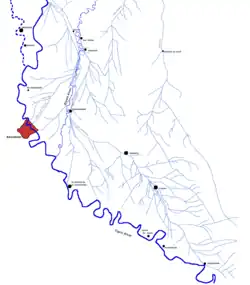Jarjaraya
Jarjarāyā was a city of medieval Iraq, surrounded by a meander of the Tigris. Capital of the district of Lower Nahrawan, it was inhabited by Persian nobles, according to Ya'qubi.[1] This has been taken to assume that Jarjaraya was founded in the Sasanian period, if not earlier.[2] By the time of Yaqut al-Hamawi in the early 1200s, however, the town was in ruins.[3] Archaeological evidence suggests that the site was abandoned by the end of the Abbasid period.[4]

Several medieval viziers had origins here, as indicated in their nisbas. Two Abbasid viziers, Al-Abbas ibn al-Hasan al-Jarjara'i and Ahmad ibn al-Khasib al-Jarjara'i, were from Jarjaraya,[5] as was the eleventh-century Fatimid vizier Abu'l-Qasim al-Jarjara'i, who held the position for 18 years.[6]
References
- Le Strange (1905), p. 37
- Adams (1965), p. 178
- Le Strange (1905), p. 37
- Adams (1965), p. 104
- Van Berkel (2013), p. 98
- Lev (1987), p. 347
Sources
- Adams, Robert M. (1965). Land Behind Baghdad: A History of Settlement on the Diyala Plains. Chicago and London: University of Chicago Press. OCLC 899942882.
- van Berkel, Maaike (2013). Crisis and Continuity at the Abbasid Court: Formal and Informal Politics in the Caliphate of al-Muqtadir. Leiden: Koninklijke Brill NV. ISBN 978-9004252707.
- Le Strange, Guy (1905). The Lands of the Eastern Caliphate: Mesopotamia, Persia, and Central Asia, from the Moslem Conquest to the Time of Timur. Cambridge: Cambridge University Press. OCLC 458169031.
- Lev, Yaacov. "Army, Regime, and Society in Fatimid Egypt, 358-487/968-1094." International Journal of Middle East Studies 19, no. 3 (1987): 337-65. Accessed March 5, 2020. www.jstor.org/stable/163658.